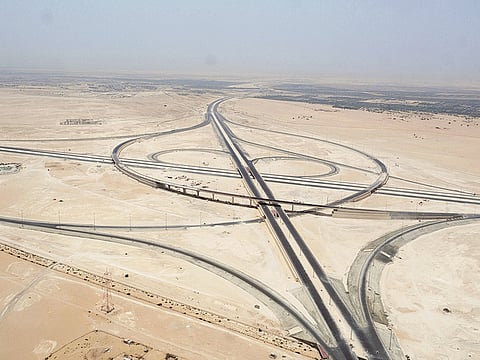New Abu Dhabi-Dubai road to be ready by end of 2016
Dh2.1b project 83% complete; new route expected to ease traffic

Abu Dhabi: Nearly 83 per cent of the new Abu Dhabi-Dubai highway has been completed and the project will be completed by the end of this year, an official statement said on Wednesday.
The Dh2.1 billion project is being executed by Abu Dhabi General Services Company (Musanada), a public joint stock company that provides facilities management, contracting and construction services to government entities.
“This road project will provide a new link to Abu Dhabi city, toward its international airport and with Yas and Saadiyat islands,” said Hamdan Al Mazrouei, acting director of roads, in the Musanada statement. He added that the new route is expected to help improve the flow of traffic between Abu Dhabi and Dubai while easing traffic congestion and reducing accident rates.
The 62-km highway is an extension of Shaikh Mohammad Bin Zayed Road (E311), and it will connect the Seih Shuaib area at the Abu Dhabi border and Dubai with the Sweihan interchange. There will be four lanes in each direction, and the highway is being built in two construction packages.
The route will cross the Forest Belt, Al Maha Forest, Khalifa Port and Industrial Zone and Bida Khalifa. It will then pass through Abu Mureikha, Zayed Military City and Al Falah area to connect with the Sweihan Interchange on the Abu Dhabi-Sweihan Road.
The project includes six interchanges, including one at Khalifa Port, as well as six underpasses.
A detailed traffic study was conducted before the start of the project, and the new highway extension is expected to have a capacity of 8,000 vehicles per hour. The motorway will also function as a strategic link that provides additional capacity to E11 (the existing Abu Dhabi-Dubai highway) for travel between the two emirates, especially during peak hours.
Before the start of the project, the Department of Transport (DoT) that oversees and regulates transportation in the emirate of Abu Dhabi also said that the new highway would be lit by 800 lighting columns placed at 300-metre intervals. In off-peak periods, these lighting columns will also reduce their power demand.
The DoT also said that the plan is for the new highway to feature six lay-bys, with three in each direction at 20-km intervals. The lay-bys will be designed for use by both heavy and light vehicles, and will also serve as patrol points for police, ambulance and other emergency response vehicles. There will also be five points for emergency responders to take U-turns.
The hard shoulders are expected to be three metres wide, and the median will be 20 metres, with a possibility for upgrades that could add two lanes in each direction if needed. It will also be equipped with guard rails to prevent median crossings. In addition, the new road will include fences on both sides to prevent the crossing of herds.
Sign up for the Daily Briefing
Get the latest news and updates straight to your inbox


